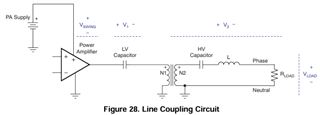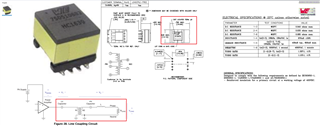Other Parts Discussed in Thread: AFE031
I want to use BOOSTXL-AFE031-DF1 board for power line communication demo over 220v/230v, 50Hz AC lines.
My question is how far it can transmit a signal in above given situations.
Best regards,
Sumit.
This thread has been locked.
If you have a related question, please click the "Ask a related question" button in the top right corner. The newly created question will be automatically linked to this question.
I want to use BOOSTXL-AFE031-DF1 board for power line communication demo over 220v/230v, 50Hz AC lines.
My question is how far it can transmit a signal in above given situations.
Best regards,
Sumit.
Hi Sumit,
how far it can transmit a signal in above given situations.
The actual PLC communication distance may vary from site to site. In the lab, we tested up to 1000 ft. I know that some customer is able to communicate up to a couple thousand feet or more. It depends on on the AC line conditions and interference, such as industrial on/off motor events, arcing, switching noises etc. The PLC Rx lines has a bandpass filter implemented at the receiver side, and it will filter out some unwanted noises, but certain noises will get through and may interfere with communication signals. So the PLC protocol does require Tx/Rx data error detection and error detection and correction mechanisms.
If you have other questions, please let me know.
Best,
Raymond
Thanks for your reply,
Other questions related to BOOSTXL-AFE031-DF1:
1) Does it required to have have line coupling circuitry while being used in 220V/230V, 50Hz.
2) I am interested to use anything other than C2000 series launchpad, is it possible?
3) If there are 1000 node (Host MCU + AFE) in PLC network how can i identify each device? MAC ID or anything else?
Hi Sumit,
1) Does it required to have have line coupling circuitry while being used in 220V/230V, 50Hz.
The AFE031EVM is the basic PLC communication PCB, the coupling circuitry that is coupled to the AC powerline is not included. The AFE031 may be coupled to DC or AC powerline, and difference powerline interface require different coupling circuitry.

The image above is the AC powerline coupling method, and link below is the transformer that is recommended for the coupling interface.
https://www.mouser.com/ProductDetail/Wurth-Elektronik/750510476?qs=k8ubvZJoN9A8PH7BTOuOqw%3D%3D
https://www.we-online.com/components/products/datasheet/750510476.pdf
2) I am interested to use anything other than C2000 series launchpad, is it possible?
Below is the link about the C2000 series launchpad EVMs. This part of interface, software codes are managed by C2000 support team. Yes, you may use the following tool to communicate with AFE031EVM, and finalize your own hardware and firmware for the PLC application.
3) If there are 1000 node (Host MCU + AFE) in PLC network how can i identify each device? MAC ID or anything else?
The PLC network, MAC ID and addressable nodes in each network are part of the firmware feature. The AFE031 hardware is able to Tx/Rx or broadcast the signals over a given network, typically PLC communication does not require to have the communication security as the application. Unlike the wireless communication network, each user has the specific ID, SIM card, and cellular network.
AFE031 model resembles the mobile device, and powerline resembles cellular network, and PLC communication is typically used as an open network communication protocol, identification of each device can be defined by users and written in the communication firmware. AFE031 is only the hardware device that is capable to send or receive data packets; PLC communication coding and decoding signals are up to the user and has to be implemented and interpreted by your firmware.
Please keep in mind, the PLC communication is limited to a given powerline (AC or DC) network or power connection. You may use PLC repeater to extend the communication distance, but a simple LPF (such as power strip, power conditioners or localized AC power transformer or distribution transformer) can attenuate or filtered out the data transmission signals due to nature of the communication media and confined power network.
If you have other questions, please let me know.
Best,
Raymond
Thank you for your reply with the circuit diagram.
My company and I are planning to develop a "Proof of Concept" on PLC technology. Could you please provide a real-life picture of the AC line coupling with AFE031? Having a real-life picture will greatly assist us in building a more solid belief in the product, as visualizing the practical application enhances our understanding and confidence in its capabilities.
Additionally, I've seen examples of the technology in action, such as:
i) Transmitting using DAC mode
ii) Transmitting using PWM mode
iii) Receiving
However, I lack in-depth knowledge of how these examples work. I would greatly appreciate a detailed explanation of each example to help me better understand the technology and its functionalities."
Hi Sumit,
Could you please provide a real-life picture of the AC line coupling with AFE031?
The size of the AC transformer is 20mm x 15mm, plus the other components. HV capacitors may have larger size than the transformer. The actual dimensions depend on the actual application and protection circuitry between output and AFE031's controller side.
This is power system interface, and it will not be very compact. But you should be able to design AFE031/Transformer interfaces about the size of iphone in area. The height will determine the size of enclosure.

However, I lack in-depth knowledge of how these examples work.
The relevant design information should be in the application note below.
https://www.ti.com/lit/an/sprac94d/sprac94d.pdf?ts=1714621319149
https://www.ti.com/lit/ug/sbou223/sbou223.pdf?ts=1714658697053
Please let me know if you have additional questions.
Best,
Raymond